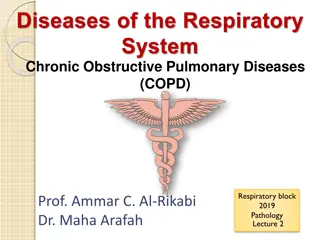
Evaluation of Patients with Chronic Diseases: A Comprehensive Guide for Medical Students
Understanding the holistic evaluation of patients with chronic diseases is crucial for advanced medical students. This guide emphasizes the importance of a systematic approach, including detailed medical history, physical examination, and diagnostic tools utilization. Key points cover medical history, past medical history, medications, family history, and social history, along with the significance of a thorough physical examination.
Download Presentation

Please find below an Image/Link to download the presentation.
The content on the website is provided AS IS for your information and personal use only. It may not be sold, licensed, or shared on other websites without obtaining consent from the author. If you encounter any issues during the download, it is possible that the publisher has removed the file from their server.
You are allowed to download the files provided on this website for personal or commercial use, subject to the condition that they are used lawfully. All files are the property of their respective owners.
The content on the website is provided AS IS for your information and personal use only. It may not be sold, licensed, or shared on other websites without obtaining consent from the author.
E N D
Presentation Transcript
E VA LUAT I O N O F PAT I E N T S W I T H C H R O N I C D I S E A S E S A G U I D E F O R A D V A N C E D M E D I C A L S T U D E N T S
PRESENTATION As an advanced medical student, it is essential to understand that the evaluation of patients with chronic diseases requires a holistic and systematic approach. Chronic diseases often involve complex and long-standing pathophysiological processes, which may lead to a variety of complications. This process requires not only a detailed clinical history and physical examination but also effective use of laboratory tests, imaging studies, and other diagnostic tools. Below is a comprehensive approach to the evaluation of patients with chronic diseases.
K E Y P O I N T S O F E V A L U AT I O N : 1. Comprehensive Medical History The history-taking process is critical in evaluating a patient with a chronic disease. It is essential to understand not only the disease- specific aspects but also the overall impact on the patient's life. Key components to address include: Chief complaint: Identify the patient's current concerns and any acute exacerbations of their chronic disease. Disease onset and progression: Inquire about the history of the disease, when it was first diagnosed, its progression, and any changes in management over time.
K E Y P O I N T S O F E V A L U AT I O N : Past medical history: Assess comorbid conditions (e.g., hypertension, diabetes, osteoarthritis) that could complicate or exacerbate the chronic disease. Medications: Review both prescribed medications and over- the-counter drugs. Consider adherence, drug interactions, and potential side effects. Family history: Chronic diseases often have a genetic component. Determine whether the patient s family members have a similar condition or any related conditions.
K E Y P O I N T S O F E V A L U AT I O N : Social history: Assess lifestyle factors such as smoking, alcohol use, diet, physical activity, and living conditions that may affect disease management. Example: For a patient with chronic kidney disease (CKD), the history should explore the duration of hypertension, diabetes, previous episodes of acute kidney injury (AKI), use of nephrotoxic drugs, and any family history of renal disease.
K E Y P O I N T S O F E V A L U AT I O N : 2. Physical Examination A thorough physical exam should be performed to assess both the chronic disease and its potential complications. The following key areas should be addressed: General appearance: Is the patient in distress? Are they malnourished, fatigued, or exhibiting signs of systemic involvement (e.g., pallor, edema)? Vital signs: Measure blood pressure, heart rate, respiratory rate, and temperature. Pay special attention to trends (e.g., chronic hypertension in a patient with CKD).
K E Y P O I N T S O F E V A L U AT I O N : Cardiovascular exam: For diseases like diabetes or heart failure, auscultate for murmurs, rales, or other signs of congestive heart failure. Respiratory exam: Look for signs of pulmonary complications, such as wheezing, crackles, or reduced air entry. Musculoskeletal exam: Evaluate for signs of osteoarthritis, joint deformities, or gait abnormalities in patients with diseases like rheumatoid arthritis.
K E Y P O I N T S O F E V A L U AT I O N : Skin exam: In diabetes, look for ulcers, rashes, or signs of infection. In autoimmune diseases, assess for rashes (e.g., lupus). Example: In a patient with chronic obstructive pulmonary disease (COPD), the physical exam may reveal barrel chest, wheezing, and use of accessory muscles.
K E Y P O I N T S O F E V A L U AT I O N : 3. Laboratory Tests Laboratory investigations help assess the severity of the chronic disease and monitor potential complications. Commonly ordered tests include: Blood tests: Complete blood count (CBC): To detect anemia, leukocytosis, or thrombocytopenia. Renal function tests (BUN, creatinine): Particularly in diseases like CKD, to assess kidney function. Metabolic panel
K E Y P O I N T S O F E V A L U AT I O N : Liver function tests: To detect hepatotoxicity in patients on long-term medications (e.g., methotrexate). Electrolytes: Important for patients on diuretics or with diseases affecting fluid balance. HbA1c: For diabetic patients to assess long-term glucose control. Lipid profile: To assess cardiovascular risk in chronic diseases like diabetes and hypertension.
K E Y P O I N T S O F E V A L U AT I O N : Urine tests: Urinalysis: Can reveal proteinuria, hematuria, or glucose, all of which are relevant in diseases like diabetes and CKD. Urine microalbumin: Early marker of renal damage in diabetes.
K E Y P O I N T S O F E V A L U AT I O N : Specialized tests: Arterial blood gases (ABG): In respiratory diseases like COPD or asthma. Thyroid function tests: In autoimmune or metabolic diseases such as Hashimoto s thyroiditis or Graves' disease.
K E Y P O I N T S O F E V A L U AT I O N : 4. Imaging Studies Imaging is crucial for diagnosing, staging, and monitoring the progression of chronic diseases. Common imaging modalities include: Chest X-ray: Useful for patients with chronic respiratory diseases (e.g., COPD, asthma, tuberculosis). Echocardiography: In patients with heart failure or suspected cardiovascular complications.
K E Y P O I N T S O F E V A L U AT I O N : Abdominal ultrasound: In patients with liver or kidney disease, such as cirrhosis or polycystic kidney disease. CT/MRI: For detailed imaging of the brain (in stroke, multiple sclerosis) or joints (in rheumatoid arthritis). Bone density scan: For osteoporosis or chronic corticosteroid use. Example: For a patient with a history of chronic back pain and suspected osteoporotic fractures, a DEXA scan (dual- energy X-ray absorptiometry) may be warranted to assess bone density.
K E Y P O I N T S O F E V A L U AT I O N : 5. Functional Assessment Assessing the patient s functional status is important to gauge the impact of the chronic disease on their daily activities. This involves evaluating: Activities of daily living (ADLs): Can the patient perform basic tasks such as dressing, bathing, cooking, and cleaning? Instrumental activities of daily living (IADLs): Does the patient manage finances, transportation, medication adherence, and social interactions effectively?
K E Y P O I N T S O F E V A L U AT I O N : Physical function: Tools such as the 6-minute walk test or Timed Up and Go (TUG) test can assess mobility, balance, and endurance. Cognitive function: In diseases like Alzheimer s or Parkinson s, assessing cognitive decline is critical. Example: For a patient with rheumatoid arthritis, it is important to assess their ability to carry out IADLs like cooking or managing medications, as joint pain and stiffness may impair these activities.
K E Y P O I N T S O F E V A L U AT I O N : 6. Patient-Centered Care and Management Plan Once the evaluation is complete, a patient-centered management plan should be developed. This should include: Setting goals: Short-term and long-term goals (e.g., reducing blood sugar in diabetes, improving mobility in arthritis). Multidisciplinary approach: Chronic disease management often requires collaboration with specialists, such as endocrinologists, cardiologists, or physical therapists.
K E Y P O I N T S O F E V A L U AT I O N : Patient education: Empower the patient with knowledge about their disease, treatment options, and lifestyle modifications. Follow-up schedule: Plan regular follow-up visits to monitor disease progression, medication side effects, and the need for adjustments in therapy. Example: In a patient with diabetes, management should focus on lifestyle modification (diet, exercise), glucose monitoring, and regular follow-up for HbA1c testing and complications assessment.
P R O T O C O L S A N D G U I D E L I N E S : Several clinical guidelines provide evidence-based protocols for managing chronic diseases. These should be integrated into your approach to patient care. Examples include: 1.American Diabetes Association (ADA) guidelines for diabetes management. 2.National Institute for Health and Care Excellence (NICE) guidelines for cardiovascular disease management. 3.Global Initiative for Chronic Obstructive Lung Disease (GOLD) guidelines for COPD management.
B I B L I O G R A P H Y Guyton and Hall Textbook of Medical Physiology, 14th Edition, Hall JE. Elsevier, 2020. Harrison s Principles of Internal Medicine, 20th Edition, Jameson JL et al. McGraw-Hill, 2018. Davidson s Principles and Practice of Medicine, 23rd Edition, S. Colledge, N.W. Walker, M. Ralston. Churchill Livingstone, 2018. Chronic Disease Epidemiology and Control, 4th Edition, M. M. Grosse et al. American Public Health Association, 2016. National Institute for Health and Care Excellence (NICE) guidelines: https://www.nice.org.uk/guidance https://aedv.fundacionpielsana.es/wp- content/uploads/2020/10/diabetesypiel-fps-r.jpg






















